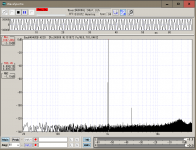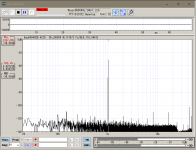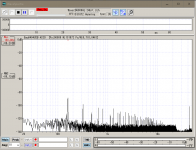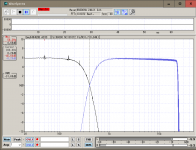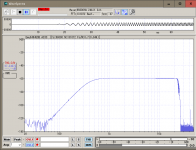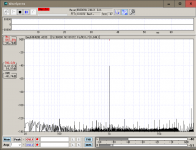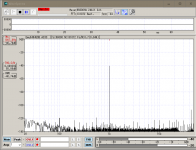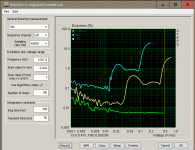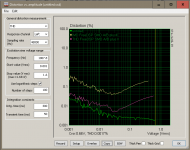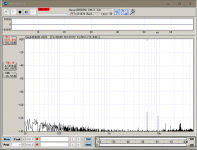Hi CyberPit-San,
Sorry for the late reply, the notification got lost in the middle of the pandemic. Tks for your great measurements.
115 dB of Dac signal would be higher than the capabilities of the adu1701.
Regarding the output of the board, yes it has a buffer output to raise the voltage of the ADU1701 to over 3 Volts. A friend and I did a teardown of the DSP-408 and that when all made sense.
Sorry for the late reply, the notification got lost in the middle of the pandemic. Tks for your great measurements.
115 dB of Dac signal would be higher than the capabilities of the adu1701.
Regarding the output of the board, yes it has a buffer output to raise the voltage of the ADU1701 to over 3 Volts. A friend and I did a teardown of the DSP-408 and that when all made sense.
I checked the connection of DSP-408 USB-A connector. It uses USB3.0 receptacle, but the signal connection is not a USB.
It's proprietary interface, so you can NOT use any general USB BT dongle for the DSP-408.
Well Thanks! That makes it easier to decide.
Discussing about the distortion, Is it at full volume or across volume range?
Member
Joined 2018
ReMeasured DSP408
Hi Gill.T-San,
I changed my USB-Audio I/F form Roland Quad-Capture to very old Emu0404USB. This is old I/F unit and I made some improving modifications.
First figure is Emu 0404USB DAC to ADC through performance.
The 2nd figure is DSP408 -30dBV Input Distortion performance. 3rd figure is DSP408 Remain Noise Spectrum without Wired Remote. 4th figure is DSP408 connected with Wired Remote.
- Full level input increases distortion more than -30dBV input.
- Wired remote connection increases some harmonic noise.
I hope this information will help to use the DSP408.
Hi Gill.T-San,
I changed my USB-Audio I/F form Roland Quad-Capture to very old Emu0404USB. This is old I/F unit and I made some improving modifications.
First figure is Emu 0404USB DAC to ADC through performance.
The 2nd figure is DSP408 -30dBV Input Distortion performance. 3rd figure is DSP408 Remain Noise Spectrum without Wired Remote. 4th figure is DSP408 connected with Wired Remote.
- Full level input increases distortion more than -30dBV input.
- Wired remote connection increases some harmonic noise.
I hope this information will help to use the DSP408.
Attachments
Last edited:
Thanks, Its concerning when an active crossover adds distortion to the chain, that too with a significant level. Any wayout to get over it?
Probably best to do the crossover digitally in the computer, then out though a good multi-channel dac. Ideally, digital audio should only ever pass though a dac once.
Another option might be go digitally into a DSP chip (maybe using USB or SPDIF input), then out through a multi-channel dac.
Never good to have the system look like: DAC/ADC/DSP/DAC
Another option might be go digitally into a DSP chip (maybe using USB or SPDIF input), then out through a multi-channel dac.
Never good to have the system look like: DAC/ADC/DSP/DAC
Last edited:
I agree with markw4 that making two a/d conversion is not the best course of action.
Gigaport ex ESI - GIGAPORT eXl
ooks perfect for the task, very few reviews, but for what I read it messures as stated (192 kHz, 114 db). For 8 channel for 200 usd seems like a bargain
Another interesting use would be a 7.1 system in windows
USB 3.1 Audio Interface with USB-C connector (different connection cables included)
USB 2.0 compatible
24-bit / 192 kHz D/A converter with 114dB dynamic range (A-weighted), available on all output channels
8 independent output channels with -10dBV RCA connectors
2 independent stereo headphone outputs: 1st output sends l out mixed signal of all playback channels, 2nd output l sends out different signal from playback channel 1/2
compatible with Windows 7 / 8.1 / 10 and OS X / macOS
supports ASIO 2.0, WDM, MME with our EWDM drivers as well as CoreAudio
100% class compliant
works with OS X / mac OS (10.9 and above) with native CoreAudio support (32-bit and 64-bit)
EWDM driver for Windows 7 / 8 / 8.1 / 10 with ASIO 2.0, MME, WDM and DirectSound (32-bit and 64-bit)
DirectWIRE Loopback support under OS X / mac OS / Windows
DirectWIRE Output Channels support under Windows for dynamic output routing
compact and portable design with around 12 cm x 7 cm x 2 cm
Gigaport ex ESI - GIGAPORT eXl
ooks perfect for the task, very few reviews, but for what I read it messures as stated (192 kHz, 114 db). For 8 channel for 200 usd seems like a bargain
Another interesting use would be a 7.1 system in windows
USB 3.1 Audio Interface with USB-C connector (different connection cables included)
USB 2.0 compatible
24-bit / 192 kHz D/A converter with 114dB dynamic range (A-weighted), available on all output channels
8 independent output channels with -10dBV RCA connectors
2 independent stereo headphone outputs: 1st output sends l out mixed signal of all playback channels, 2nd output l sends out different signal from playback channel 1/2
compatible with Windows 7 / 8.1 / 10 and OS X / macOS
supports ASIO 2.0, WDM, MME with our EWDM drivers as well as CoreAudio
100% class compliant
works with OS X / mac OS (10.9 and above) with native CoreAudio support (32-bit and 64-bit)
EWDM driver for Windows 7 / 8 / 8.1 / 10 with ASIO 2.0, MME, WDM and DirectSound (32-bit and 64-bit)
DirectWIRE Loopback support under OS X / mac OS / Windows
DirectWIRE Output Channels support under Windows for dynamic output routing
compact and portable design with around 12 cm x 7 cm x 2 cm
Member
Joined 2018
Actual Linkwitz-Reiley 24dB/oct @400Hz Distortion Performance
Hi Gill.t-San,
I guess, you are concerning the actual sound quality of crossover dividing network application.
Attached figures are DSP408 LR24dB/oct @400Hz Crossover Performance
1. 1kHz Distortion (-40dBV, Defeat Through)
2. 1kHz Distortion (-40dBV, HPF@400Hz)
3. HPF Output Frequency Response
4. Crossover Point
(Note)
Figure-4 contains some sags, this is depend on my measurement system, not contained in DSP408 sound output.
I can say, there are very small damage in processing 24dB/oct crossover processing. But the large signal input distortion (above -30dBv) should be consider when using DSP-408 system mean level settings.
Hi Gill.t-San,
I guess, you are concerning the actual sound quality of crossover dividing network application.
Attached figures are DSP408 LR24dB/oct @400Hz Crossover Performance
1. 1kHz Distortion (-40dBV, Defeat Through)
2. 1kHz Distortion (-40dBV, HPF@400Hz)
3. HPF Output Frequency Response
4. Crossover Point
(Note)
Figure-4 contains some sags, this is depend on my measurement system, not contained in DSP408 sound output.
I can say, there are very small damage in processing 24dB/oct crossover processing. But the large signal input distortion (above -30dBv) should be consider when using DSP-408 system mean level settings.
Attachments
Member
Joined 2018
DSP408 Level vs. Distortion
Attched Additional measurement of DSP408 distortions.
THD/IMD vs. Input Level attached.
Untitled green trace is Emu0404USB itself performance.
Attched Additional measurement of DSP408 distortions.
THD/IMD vs. Input Level attached.
Untitled green trace is Emu0404USB itself performance.
Attachments
Last edited:
Member
Joined 2018
FYI: FreeDSP Classic SMD A/B plus-II performance
To know the ADAU1701 device's audio performance and it's characteristics, I measured my FreeDSP Classic SMD A/B plus II. (Crossover 24dB/oct@400Hz HPF output)
1st figure is IMD/THD vs. Input Level. (Green trace is 0404USB it's self)
2nd figure is 1kHz Sin-wave 1.8V input distortion performance.
3rd figure is Remain Noise Spectrum.
Comparing this measured result and DSP408's result shows, there might be some room to improve the Large level signal input distortion performance of DSP408.😉
To know the ADAU1701 device's audio performance and it's characteristics, I measured my FreeDSP Classic SMD A/B plus II. (Crossover 24dB/oct@400Hz HPF output)
1st figure is IMD/THD vs. Input Level. (Green trace is 0404USB it's self)
2nd figure is 1kHz Sin-wave 1.8V input distortion performance.
3rd figure is Remain Noise Spectrum.
Comparing this measured result and DSP408's result shows, there might be some room to improve the Large level signal input distortion performance of DSP408.😉
Attachments
Last edited:
Can the Dayton dsp take speakers before the amp? I know you can use speaker level inputs correct? How would one wire a 3 way speaker with this? Possible to before the amp so I can power all 3 speakers off one channel?
I am always on the look for a active crossover with the flexibility of tailoring the sound and with frequency adjustment for the individual drivers, hence the interest in reading all I can about them. The Dayton has been on the radar for a while but never tried it.
I'm also keen on keeping it analogue but these unit I believe have some sort of digital conversion of the signal for them to work.
So far I've tried a few. Mini DSP was one the very cheapest below the HD. Absolute garbage I thought, like putting a blanket over the speakers, bit of an exaggeration but you get my meaning.
The other one I tried was the Thomman cheap one here. This one I thought was a little better but still took something away from the original signal listening critically with headphones.
the t.racks DSP 4x4 Mini – Thomann UK
So I'm still on the look, perhaps I will try the Dayton one day.
Another bargain I found was one on Ali, this one looks like it'll do the business but no idea really how it would compare. It gives you the option to do things remotely as well which I thought was a very nice to have.
Leicozic 8 In8Out 32Bit DSP Processor Digital Professional Procesador De Audio WIFI USB 7Band EQ Equalizer Screen Touchable|Stage Audio| - AliExpress
I'm also keen on keeping it analogue but these unit I believe have some sort of digital conversion of the signal for them to work.
So far I've tried a few. Mini DSP was one the very cheapest below the HD. Absolute garbage I thought, like putting a blanket over the speakers, bit of an exaggeration but you get my meaning.
The other one I tried was the Thomman cheap one here. This one I thought was a little better but still took something away from the original signal listening critically with headphones.
the t.racks DSP 4x4 Mini – Thomann UK
So I'm still on the look, perhaps I will try the Dayton one day.
Another bargain I found was one on Ali, this one looks like it'll do the business but no idea really how it would compare. It gives you the option to do things remotely as well which I thought was a very nice to have.
Leicozic 8 In8Out 32Bit DSP Processor Digital Professional Procesador De Audio WIFI USB 7Band EQ Equalizer Screen Touchable|Stage Audio| - AliExpress
I think the main problem you are facing is ADC.
The MiniDSP (non HD) and probably the Thomann, use the ADAU 1701 which comes with not so good ADC. The DAC are not uber terrible, but there are better ones.
One thing you might try is to bypass the analog to digital conversion, maybe by feeding your DSP with an I2S signal (USB to I2S maybe).
The Dayton also uses the ADAU1701, in fact it seems it uses dual ADAU1701 (I`ve read it somewhere), but the performance it's very similar... I know the "devil" is in the implementation of the chipset, but still the ADAU1701 it's very limited "ADC wise".
I have an ADAU1452 with AD1938 codec which is much better (spec wise) but it's implementation it's not great, so performance is also poor.
You can find better ADC in Hypex Fusion Amps, Aurora DSP and some other MiniDSP higher end models... but still the ADC is the Achilles heel, more now that there is a shortage of AKM chipsets.
The MiniDSP (non HD) and probably the Thomann, use the ADAU 1701 which comes with not so good ADC. The DAC are not uber terrible, but there are better ones.
One thing you might try is to bypass the analog to digital conversion, maybe by feeding your DSP with an I2S signal (USB to I2S maybe).
The Dayton also uses the ADAU1701, in fact it seems it uses dual ADAU1701 (I`ve read it somewhere), but the performance it's very similar... I know the "devil" is in the implementation of the chipset, but still the ADAU1701 it's very limited "ADC wise".
I have an ADAU1452 with AD1938 codec which is much better (spec wise) but it's implementation it's not great, so performance is also poor.
You can find better ADC in Hypex Fusion Amps, Aurora DSP and some other MiniDSP higher end models... but still the ADC is the Achilles heel, more now that there is a shortage of AKM chipsets.
The problem with those boxes is mostly in the quality of the ADC/DAC sections. The DSP part is probably an ADI Sigma DSP chip in every case.
First of all, its better to avoid added cost and added distortion of unnecessary ADC/DAC conversions.
Best to keep it digital until after all the DSP is done, then convert to analog as the very last processing step. Use a good enough DAC to satisfy your needs.
EDIT: Looks like I cross posted with mga2009.
First of all, its better to avoid added cost and added distortion of unnecessary ADC/DAC conversions.
Best to keep it digital until after all the DSP is done, then convert to analog as the very last processing step. Use a good enough DAC to satisfy your needs.
EDIT: Looks like I cross posted with mga2009.
Interesting reading.
These DSP units offer superb tailoring options but come at a cost if you ask me. Especially if you have an all analogue system vinyl or tape. But even with CD or DAC of choice though, you dont want to have that good DAC signal converted after its come out of your lovely machine and be re processed again and lose some of that goodness you bought that machine for in the first place.
I've even just thought about using adjustable gain power amps to the drive units and adding a full analogue eq to each stereo channel. I expect the result of that may even be better than these cheap DSP units even though it doesn't give as much tailoring adjust on things.
Something like one of these on each of the stereo drivers. Could give some control.
Behringer FBQ800 – Thomann UK
These DSP units offer superb tailoring options but come at a cost if you ask me. Especially if you have an all analogue system vinyl or tape. But even with CD or DAC of choice though, you dont want to have that good DAC signal converted after its come out of your lovely machine and be re processed again and lose some of that goodness you bought that machine for in the first place.
I've even just thought about using adjustable gain power amps to the drive units and adding a full analogue eq to each stereo channel. I expect the result of that may even be better than these cheap DSP units even though it doesn't give as much tailoring adjust on things.
Something like one of these on each of the stereo drivers. Could give some control.
Behringer FBQ800 – Thomann UK
Last edited:
DSP is awesome, and so is active crossover, but obviously it's "limited" to the digital domain.
I am pretty sure that a digital source > USB > I2S > ADAU1701 > I2S > GOOD DAC = awesome performance.
Once you add an ADC to the chain, performance goes down the toilet, at least with these cheap DSP... if you are using a high performance MOTU interface, then their ADC are quite good.
I am pretty sure that a digital source > USB > I2S > ADAU1701 > I2S > GOOD DAC = awesome performance.
Once you add an ADC to the chain, performance goes down the toilet, at least with these cheap DSP... if you are using a high performance MOTU interface, then their ADC are quite good.
...Especially if you have an all analogue system vinyl or tape...
My feeling, too.
A cheap graphic EQ may not be ideal either though. If one were really needed maybe better to build it from scratch. Ideally its good to work on speaker placement and room treatment first, then see if any additional EQ is still needed after that.
Last edited:
Yes I get all this.
And as mga2009 says if you can keep the tweeking all in the digital domanin great. The only trouble is the good DAC is only stereo output so tailoring each drive unit wont be an option unless you have multiple good DACs, which could be a very costly option.
And as mga2009 says if you can keep the tweeking all in the digital domanin great. The only trouble is the good DAC is only stereo output so tailoring each drive unit wont be an option unless you have multiple good DACs, which could be a very costly option.
The "cheapest" good option (quite DIY) is this:
8 Channels 384kHz 32bit ES9038PRO PCM DXD DSD Audio DAC - DIYINHK
The best option I think is Okto Research DAC8
8 Channels 384kHz 32bit ES9038PRO PCM DXD DSD Audio DAC - DIYINHK
The best option I think is Okto Research DAC8
- Home
- Source & Line
- Digital Line Level
- Dayton Audio DSP-408
